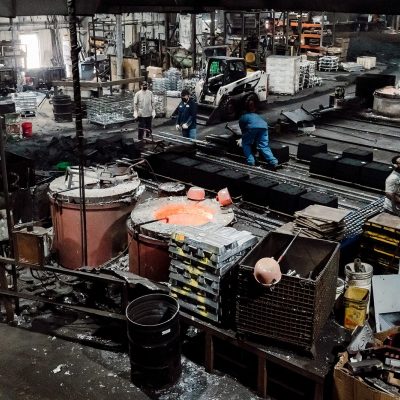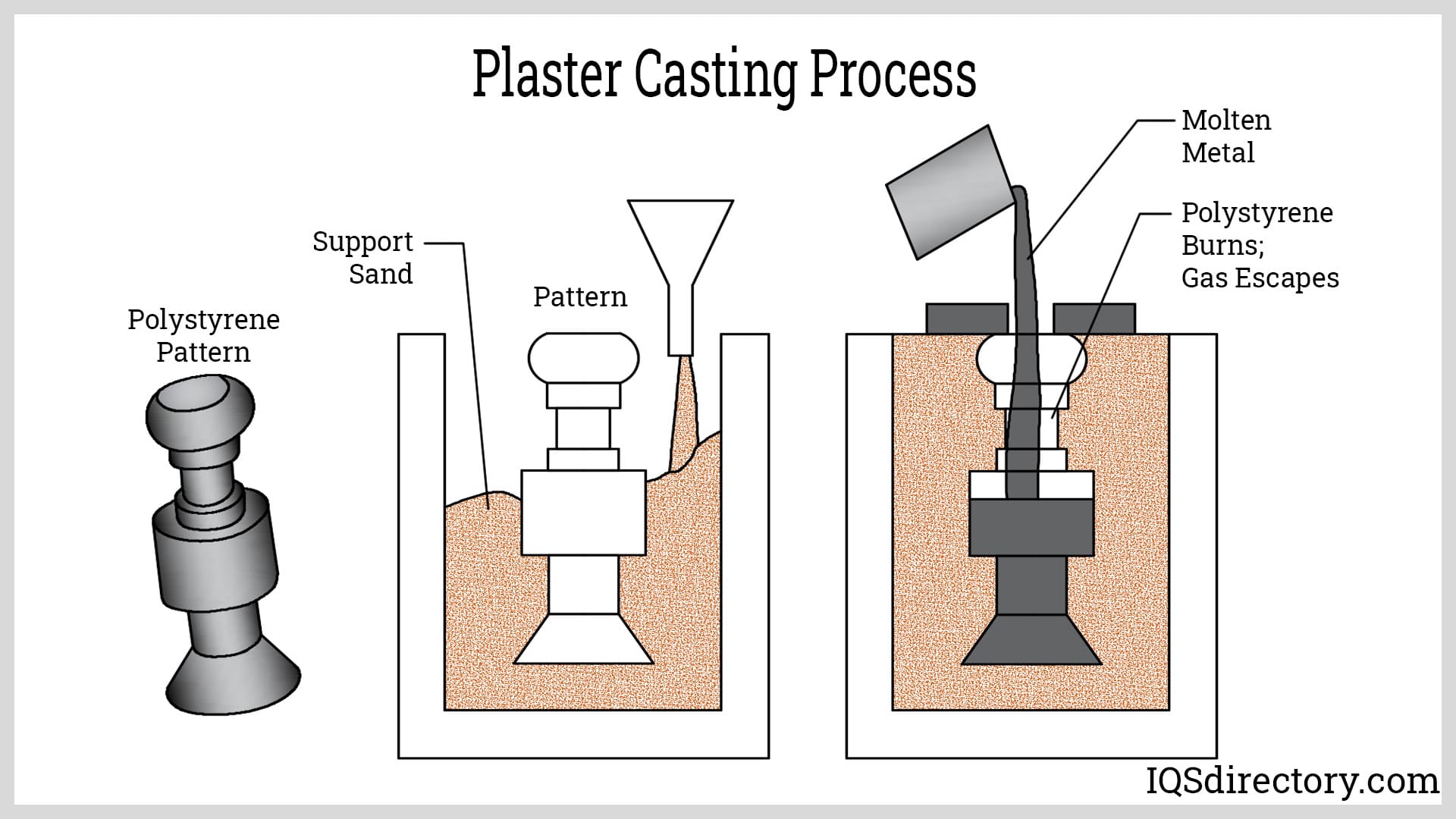Understanding the Steel Castings Refine: A Comprehensive Guide for Beginners
The Metal Casting process is a basic strategy in making that changes molten steel into solid kinds. Beginners must realize the different techniques involved, such as sand spreading and die spreading. Comprehending the products, style principles, and precaution is similarly crucial. Each aspect plays an important role in accomplishing successful outcomes. As one navigates these complexities, the question of just how to maximize each action for boosted outcomes becomes significantly pertinent.
The Fundamentals of Steel Casting
Although Metal Casting has actually developed over centuries, its essential principles stay integral and constant to the production procedure. At its core, Metal Casting includes the improvement of liquified metal right into strong objects with different methods. The process starts with the creation of a mold, which defines the form of the end product. Once the mold is prepared, metal is heated to its melting factor and put into the dental caries. After cooling, the metal strengthens, taking the form of the mold and mildew.
There are numerous casting techniques, consisting of sand spreading, financial investment spreading, and pass away spreading, each with unique advantages and applications. The choice of technique depends on variables such as production quantity, product type, and preferred accuracy. As soon as cast, the last item might undertake additional processes like machining or surface therapy to achieve the required coating and specifications. Understanding these basics is vital for any individual thinking about the field of Metal Casting.

Recognizing Products Made Use Of in Metal Casting
Products play a crucial duty in the Metal Casting process, affecting the end product's homes and performance. Numerous metals are made use of, including light weight aluminum, iron, bronze, and steel, each offering unique features suited for particular applications. Light weight aluminum is light-weight and corrosion-resistant, making it perfect for automotive parts. Iron, particularly cast iron, is preferred for its outstanding wear resistance and resilience. Steel supplies high stamina and convenience, commonly utilized in heavy machinery elements. Bronze, understood for its rust resistance and machinability, is frequently used in marine applications.
In enhancement to the metals, numerous casting products, such as sand, plaster, and ceramic, are made use of to develop mold and mildews. Sand spreading, the most prevalent technique, utilizes silica sand because of its thermal stability and capacity to form detailed forms. Plaster and ceramic mold and mildews use finer information yet might need more complex procedures. The option of materials directly impacts the efficiency, cost, and top quality of the casting procedure.
The Style Process: From Idea to Blueprint
The style process in Metal Casting begins with the initial concept advancement, where concepts are produced and assessed. This is complied with by the application of CAD modeling methods, permitting accurate visualizations of the design. Finally, the plan completion steps assure that all specifications are accurately recorded for production.
First Principle Advancement
First principle advancement marks a crucial phase in the Metal Casting procedure, where ideas change right into tangible styles. During this stage, designers team up with stakeholders and designers to brainstorm and fine-tune preliminary principles. They think about elements such as performance, aesthetics, and manufacturability, making sure that the design satisfies the required specifications and efficiency standards. Illustrations and rough drafts are developed to imagine the concepts, permitting for preliminary assessments of usefulness and cost-effectiveness. This stage likewise includes determining products and potential casting approaches that line up with the style goals. Inevitably, first idea development lays the foundation for an extensive blueprint, guiding the subsequent phases of the spreading process and ensuring an effective shift from idea to fact.
CAD Modeling Techniques
Changing principles right into specific layouts, CAD modeling strategies play a pivotal function in the Metal Casting procedure. These strategies make use of innovative software to produce thorough three-dimensional versions that accurately show the desired product. By utilizing tools such as parametric modeling, solid modeling, and surface modeling, developers can adjust measurements and forms with convenience. CAD systems additionally facilitate simulation and evaluation, permitting the recognition of prospective defects prior to manufacturing begins. This positive method reduces product waste and maximizes the style for manufacturability. In addition, CAD models can be easily changed, allowing fast models based upon comments. Essentially, CAD modeling works as the foundation of the layout procedure, connecting the gap between initial ideas and the ultimate production-ready designs.
Blueprint Finalization Tips
Following the development of comprehensive CAD models, the following stage involves blueprint completion, which is critical in equating electronic styles right into actionable plans for manufacturing. This procedure begins with assessing the CAD designs for accuracy and conformity with requirements. When validated, the measurements, tolerances, and material specs are diligently detailed to guarantee clearness. Integrating notes and comments helps communicate crucial info concerning spreading processes, surface finishes, and assembly demands. The wrapped up blueprint goes through an extensive authorization procedure, commonly including cooperation with designers and production teams to resolve any type of potential concerns. Besides modifications are made and authorizations gotten, the blueprint is formally launched, working as the foundational file for the succeeding phases of Metal Casting, including pattern making and mold style.
The Metal Casting Methods Discussed

Metal Casting methods encompass a variety of approaches used to shape liquified metal into wanted forms. These strategies differ according to the kind of product, complexity of the layout, and manufacturing quantity. Sand spreading is one of the most common methods, involving the production of a mold from sand to hold the molten steel. Financial investment casting, or lost-wax spreading, enables for elaborate layouts by utilizing a wax pattern that is thawed away. Pass away casting utilizes high-pressure shot of liquified steel right into a mold, appropriate for automation. Other methods consist of permanent mold and mildew spreading, which utilizes reusable molds, and centrifugal spreading, where rotational pressures aid in filling the mold and mildew. Each method has its benefits and applications, making it essential for makers to choose the ideal approach based upon their specific requirements and needs. Understanding these strategies is necessary for anybody associated with the Metal Casting process.
Completing Processes: Enhancing Your Casted Item

Completing procedures play an essential duty in improving the high quality and appearance of casted items. Different surface therapy methods, such as polishing and covering, are used to enhance sturdiness and aesthetics. In addition, quality assessment approaches assure that the last product fulfills specified standards and performance requirements.
Surface Therapy Methods
A variety of surface treatment strategies play a crucial function in boosting the quality and longevity of casted products. These strategies include approaches such as shot blasting, brightening, and coating. Shot blasting effectively gets rid of surface area flaws, improving the functional and visual characteristics of the casting. Sprucing up supplies a smooth finish, which is especially vital for decorative discover this applications and elements requiring minimal friction. Coating methods, such as electroplating or powder finish, offer added protection against rust and wear, guaranteeing durability. Surface area therapies can improve attachment for subsequent processes, such as painting or bonding. By using these methods, manufacturers can accomplish exceptional surface area high quality, which is vital for the performance and life expectancy of Metal Casting in numerous applications.
Top Quality Evaluation Techniques
Effective high quality inspection techniques are essential for guaranteeing the honesty and performance of casted products after the finishing processes. Various strategies are used to analyze the top quality of Metal Casting, consisting of aesthetic assessment, you could try these out dimensional checks, and non-destructive testing (NDT) Visual examination permits the recognition of surface area issues, while dimensional checks guarantee that items fulfill specified tolerances. NDT approaches, such as ultrasonic testing and radiographic examination, offer deeper understandings into interior integrity without harming the spreadings. Furthermore, mechanical testing, such as tensile and solidity examinations, assesses material buildings - Metal Castings. By employing a mix of these techniques, manufacturers can enhance product high quality and dependability, eventually leading to better consumer contentment and minimized production prices
Safety Considerations in Metal Casting
While the Metal Casting procedure offers various benefits, it additionally presents a variety of security hazards that have to be carefully taken care of. Workers in casting centers are exposed to high temperatures, liquified steels, and hazardous products, which can bring about extreme injuries if correct safety measures are not taken. Personal protective tools (PPE) such as heat-resistant handwear covers, encounter shields, and safety clothing is crucial to minimize threats.
Furthermore, the existence of fumes and dirt requires proper air flow systems to ensure air quality - Metal Castings. Routine training on safety and security protocols is crucial for all employees to acknowledge possible threats and react efficiently. Emergency situation procedures ought to be developed, consisting of fire precaution and initial help availability. Upkeep of equipment and proper handling of materials additionally add to a more secure working setting. By prioritizing these safety considerations, Metal Casting operations can safeguard their workforce and keep reliable manufacturing procedures
Regularly Asked Inquiries
What Are the Environmental Influences of Metal Casting?
Metal Casting can result in ecological impacts such as air and water contamination, resource deficiency, and power intake. In addition, incorrect waste monitoring and discharges from foundries add to eco-friendly disturbances and wellness threats for nearby communities.
How Do I Choose the Right Steel for Spreading?
To pick the best steel for spreading, one must think about factors such as mechanical properties, deterioration resistance, thermal conductivity, and price. Reviewing the designated application and environmental conditions is important for suitable selection.
What Are the Common Defects in Metal Casting?
Typical issues in Metal Casting include porosity, shrinkage, sand incorporation, and misruns. These issues frequently arise from inappropriate product option, poor style, or defects in the spreading procedure, affecting the end product's top quality and efficiency.
How Can I Enhance My Steel Casting Skills?
To improve Metal Casting abilities, one ought to practice continually, research study casting strategies, examine previous projects for issues, look for responses from skilled casters, and constantly trying out various products and techniques to improve effectiveness and understanding.
What Is the Price of Beginning a Steel Spreading Company?
Beginning a metal spreading company generally calls for a first financial investment of $5,000 to $50,000, depending on equipment, materials, and center expenses. Factors like place and scale can considerably affect discover here overall startup expenses.
The Metal Casting process is an essential method in making that transforms molten steel right into strong forms. Novices must understand the numerous techniques involved, such as sand spreading and die casting. There are several casting approaches, consisting of sand casting, financial investment casting, and die casting, each with unique benefits and applications. Financial investment casting, or lost-wax casting, allows for detailed styles by using a wax pattern that is melted away. Various other methods consist of long-term mold spreading, which makes use of recyclable molds, and centrifugal casting, where rotational forces aid in filling up the mold.